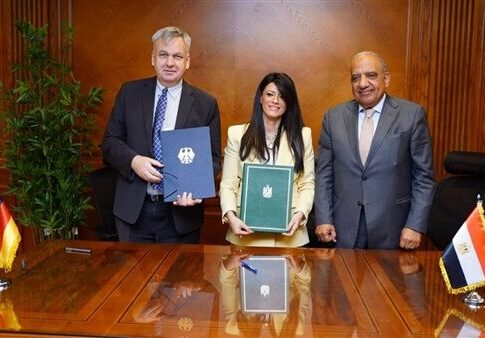Egypt has finalized a €139 million financial cooperation and debt swap agreement with Germany. The deal—signed by Egypt’s Minister of Planning and Economic Development Rania Al-Mashat and German Ambassador Jürgen Scholz—not only underscores the depth of bilateral ties between Cairo and Berlin but also signals the emergence of Egypt as a key innovator in the use of debt-for-development diplomacy.
The agreement consists of two components: approximately €118 million in financial cooperation, and a new €21 million tranche of a broader debt swap program focused on expanding Egypt’s renewable energy supply. Together, these initiatives are poised to deliver both immediate infrastructure results and long-term strategic dividends in climate resilience and human capital development.
A key highlight of the deal is the allocation of €86 million—€54 million in concessional loans and €32 million in grants—toward the integration of two major wind power facilities, ACWA Power 1 and ACWA Power 2, into Egypt’s national grid. With a combined generation capacity of 1,100 megawatts, these projects will provide clean electricity to more than 2.5 million Egyptian households under the framework of the “Novi” national climate initiative, which Germany supports as Egypt’s largest bilateral partner. The project advances Egypt’s climate pledges made during COP27 and reaffirms its position as a regional hub for renewable energy investments.
Beyond energy, the deal invests in Egypt’s future workforce. A €32 million grant will support the establishment of 25 Egyptian Centers of Excellence, specialized vocational institutions designed to align education with market demands. These centers are expected to modernize technical education in Egypt, upskilling youth and strengthening employment pipelines in key industries such as logistics, manufacturing, and renewable energy.
With this latest tranche, Egypt’s total debt swapped with Germany since 2011 now stands at approximately €297 million. According to Minister Al-Mashat, the agreement is more than a financial tool—it’s a real-world implementation of global calls for a restructured international financial order. “This approach reflects Egypt’s commitment to responsible, transparent, and impact-oriented development,” she said.
The Ministry of Electricity and Renewable Energy has also played a central role in Egypt’s transformation into a green energy powerhouse. Minister Mahmoud Esmat highlighted the extensive legislative and infrastructure reforms that have positioned Egypt as one of the most attractive destinations for private and international investors in renewable energy.
Meanwhile, Ambassador Scholz emphasized that Germany views Egypt as a cornerstone partner in achieving global climate objectives. “Our support to Egypt’s Novi initiative and this latest round of debt swaps represent a long-term partnership built on shared goals for sustainability and innovation,” he said.
While the Egypt-Germany agreement is exemplary in its scale and execution, officials and analysts alike are now asking: Can this model be replicated?
Dr. Karim Hanafy, a sovereign finance expert at Cairo University, believes it can. “Egypt has established a governance structure—anchored in the Ministry of Planning and supported by the Central Bank and sectoral ministries—that ensures the proper deployment of debt swap proceeds. This makes it a viable model for other bilateral relationships.”
Indeed, Egyptian government insiders have confirmed that Cairo is actively exploring similar frameworks with other creditor nations. The strategy is to align each swap with the creditor country’s strategic development interests:
- Italy: Egypt could propose a debt swap focused on agriculture and food security, leveraging Italy’s agri-tech expertise to modernize irrigation, sustainable farming, and Mediterranean food supply chains.
- France: A digital infrastructure and mobility-focused swap could be proposed, especially in smart transportation, fintech, and digital education platforms where French firms are competitive.
- Japan: Cairo could pursue a debt-for-resilience model with a focus on disaster preparedness, smart cities, and robotics, areas where Japan has a technological edge.
- China: With China being Egypt’s largest bilateral creditor, a green industrial zone development swap could align both Belt & Road objectives and Egypt’s Vision 2030, targeting export-oriented light manufacturing in renewable energy equipment or EV components.
- United Arab Emirates (UAE): Egypt could frame a fintech and climate finance debt swap that taps into the UAE’s sovereign wealth funds and innovation ecosystem.
Each proposed arrangement would follow Egypt’s proven governance model—coordinated by the Ministry of Planning, supported by German Development Bank-like institutions on the creditor side, and guided by measurable outcomes in line with the UN Sustainable Development Goals (SDGs).
At a time when Middle-Income Countries (MICs) are squeezed by inflation, currency volatility, and external debt obligations, Egypt’s debt-for-development diplomacy offers a flexible yet rigorous alternative to austerity. As global financial architecture continues to face calls for reform, Egypt is not waiting for top-down change—it is creating bottom-up solutions, one bilateral partnership at a time.
With strategic vision and the right international partners, Egypt could become the Global South’s most compelling case study for how debt, when structured correctly, becomes not a burden—but a springboard.


